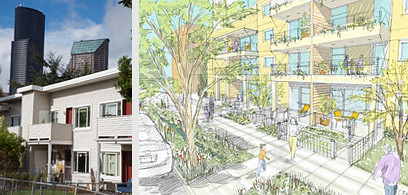
An election night tour has inspired two of Seattle’s urban journals to pen essays on the present — and future — of Yesler Terrace. Meanwhile, the Environmental Impact Statement for an ambitious overhaul of the area has been released. You can access the document here (pdf).
The Seattle Housing Authority’s has been working since 2007 on a future vision for the nearly 70 year old development that sits on 38 acres of land above I-5 and south of Harborview hospital. The plan would add market rate housing and office space to fund the replacement of the existing 561 extremely-low-income housing units and create additional units for low income and workforce housing. CDN documented some of the early steps in the planning process here and again here.
The future Yesler Terrace as envisioned in the EIS document would be a major overhaul of the area
- 5,000 apartment units
- 1.2 million sqft of office
- 88,000 sqft retail
- 50,000 sqft services
- 7 acres of open space
Here is the information submitting comments on the EIS. You can also read more about it in this release from the Seattle Housing Authority.
Comments on the Draft EIS may be submitted in writing by December 13. Comments may be e-mailed to [email protected] or sent by U.S. mail to: Seattle Housing Authority, ATTN: Stephanie Van Dyke, 120 Sixth Avenue North, P.O. Box 19028, Seattle, WA 98109-1028.
Comments may also be delivered orally at a public meeting on November 30, 2010. The meeting will be held at the old Yesler Terrace Gym at 835 East Yesler Way, from 6 to 8 p.m.
For inspiration, here are those two write-ups from the tour we mentioned. In typical Crosscut fashion, their reporter focused on Yesler Terrace’s past in an attempt to tell us something about Seattle’s future:
Seattle, a spread out city of houses, has never liked the idea that it might have slums. It has never needed to like the idea because it doesn’t have large blighted areas — even Hooverville in the tideflats didn’t take up much space and was seldom seen. On the western slope of First Hill and Capitol Hill were streets of abandoned houses and run-down apartments whose major business was prostitution.
Environmentally-focused site Grist focused on the potential for increasing density in the city’s core:
A city planner, when he heard I wrote for a “green” news site, wanted to tell me about the mini-parks and indigenous landscaping in the plans. That sort of greenery is great — essential, in fact. But the main environmental win is simply doing infill that allows more people to use a central, well-connected location.
